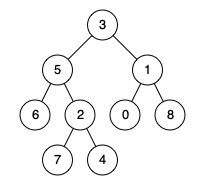151 - 236 二叉树的最近公共祖先
题目
给定一个二叉树, 找到该树中两个指定节点的最近公共祖先。
百度百科中最近公共祖先的定义为:“对于有根树 T 的两个结点 p、q,最近公共祖先表示为一个结点 x,满足 x 是 p、q 的祖先且 x 的深度尽可能大(一个节点也可以是它自己的祖先)。”
例如,给定如下二叉树: root = [3,5,1,6,2,0,8,null,null,7,4]

示例 1:
输入: root = [3,5,1,6,2,0,8,null,null,7,4], p = 5, q = 1 输出: 3 解释: 节点 5 和节点 1 的最近公共祖先是节点 3。
示例 2:
输入: root = [3,5,1,6,2,0,8,null,null,7,4], p = 5, q = 4 输出: 5 解释: 节点 5 和节点 4 的最近公共祖先是节点 5。因为根据定义最近公共祖先节点可以为节点本身。
说明:
所有节点的值都是唯一的。
p、q 为不同节点且均存在于给定的二叉树中。
解答
这个人巨骚的解法,代码就是要理解半天的那种。。
Runtime: 648 ms, faster than 5.01% of Python3 online submissions for Lowest Common Ancestor of a Binary Tree.
Memory Usage: 37.6 MB, less than 5.55% of Python3 online submissions for Lowest Common Ancestor of a Binary Tree.
虽然速度极慢。。
Runtime: 76 ms, faster than 88.50% of Python3 online submissions for Lowest Common Ancestor of a Binary Tree.
Memory Usage: 22.8 MB, less than 91.67% of Python3 online submissions for Lowest Common Ancestor of a Binary Tree.
正常写,速度就快了不少,而且可读性也好了不少。。
看来不能乱炫技
估计是在数组里面拿出来拿进去,很浪费内存和性能。
Runtime: 64 ms, faster than 87.47% of JavaScript online submissions for Lowest Common Ancestor of a Binary Tree.
Memory Usage: 41.4 MB, less than 75.00% of JavaScript online submissions for Lowest Common Ancestor of a Binary Tree.
Runtime: 12 ms, faster than 85.53% of Go online submissions for Lowest Common Ancestor of a Binary Tree.
Memory Usage: 7.5 MB, less than 100.00% of Go online submissions for Lowest Common Ancestor of a Binary Tree.
Last updated
Was this helpful?